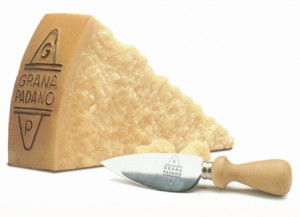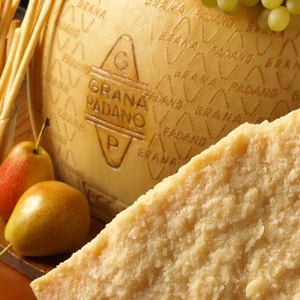Grana PadanoGrana Padano
 La nascita del Grana Padano è una storia affascinante, che risale all’anno mille e all’ingegno dei monaci benedettini. L’opera di bonifica compiuta dai monaci Cistercensi dell’abbazia di Chiaravalle favorì il diffondersi dell’allevamento del bestiame, che generò ben presto una ricca disponibilità di latte, di gran lunga superiore al fabbisogno della popolazione.
La nascita del Grana Padano è una storia affascinante, che risale all’anno mille e all’ingegno dei monaci benedettini. L’opera di bonifica compiuta dai monaci Cistercensi dell’abbazia di Chiaravalle favorì il diffondersi dell’allevamento del bestiame, che generò ben presto una ricca disponibilità di latte, di gran lunga superiore al fabbisogno della popolazione.
Fu così che i monaci misero a punto la “ricetta” del Grana Padano, geniale espediente per la conservazione dell’eccedenza di latte.
Nasce così un formaggio a pasta dura che stagionando, conserva i principi nutritivi del latte e acquista un sapore inconfondibile, dolce e saporito allo stesso tempo. Formaggio a cui viene spontaneamente attribuito il nome di “grana” per la pasta granulosa che lo caratterizza.
La fama del Grana Padano si consolida nel tempo e ben presto diviene formaggio pregiato protagonista dei banchetti rinascimentali di principi e duchi, ma anche principale alimento di sostentamento delle genti delle campagne durante le terribili carestie.
Un formaggio dalle due anime: ingrediente di spicco delle ricette dell’elaborata cucina nobiliare e caposaldo della tradizione gastronomica popolare.
Con il passare del tempo la pratica della trasformazione del latte in “Grana” si diffonde, tanto da diventare uno dei pilastri dell’economia agricola.
La tradizione produttiva del Grana Padano si è tramandata nei secoli secondo metodologie invariate che assicurano ancora oggi al prodotto le caratteristiche organolettiche e l’aspetto che lo hanno reso celebre in tutto il mondo.
 Il Grana Padano è un formaggio DOP che, come prevede il Disciplinare Produttivo, deve essere prodotto con latte crudo di vacca, proveniente da non più di due munte giornaliere e prodotto solo in caseifici autorizzati dall’ente certificatore (attualmente il CSQA).
Il Grana Padano è un formaggio DOP che, come prevede il Disciplinare Produttivo, deve essere prodotto con latte crudo di vacca, proveniente da non più di due munte giornaliere e prodotto solo in caseifici autorizzati dall’ente certificatore (attualmente il CSQA).Il latte parzialmente scremato per decrematura naturale è trasferito in caldaie tradizionali in rame a doppio fondo della capacità tale per ricavarne, al massimo, due forme.
Al latte si aggiunge il siero naturale.
 The origin of Grana Padano is a fascinating tale, dating back to around 1100 AD and the cleverness of the Benedictine monks. The improvements carried out on the land by Cistercian monks of the Chiaravalle Abbey led to the growth of livestock breeding, which soon resulted in large quantities of milk becoming available, far exceeding the needs of the inhabitants.
The origin of Grana Padano is a fascinating tale, dating back to around 1100 AD and the cleverness of the Benedictine monks. The improvements carried out on the land by Cistercian monks of the Chiaravalle Abbey led to the growth of livestock breeding, which soon resulted in large quantities of milk becoming available, far exceeding the needs of the inhabitants.
Consequently, the monks devised the Grana Padano “recipe”, an ingenious way of preserving the surplus milk.
And so a hard cheese was created which, when aged, retains the main nutrients of milk and acquires an unmistakeable flavour, both mild and flavoursome. A cheese which was spontaneously given the name of “grana” due to its characteristic grainy texture.
The reputation of Grana Padano was established over time and the product soon became a highly-esteemed prize ingredient at Renaissance banquets held by princes and dukes, but also a main source of nourishment for people in rural areas during the terrible times of famine. A cheese with two souls: a staple ingredient of recipes belonging to the elaborate cuisine of the nobility and a basic element of traditional everyday cooking.
Over time, the practice of turning milk into “Grana” became more widespread, making it one of the pillars of the farming economy. The traditional methods of producing Grana Padano have been handed down unchanged through the centuries, ensuring that the product continues to display today the characteristics of flavour, aroma and texture, as well as appearance, for which it is world famous.
 Grana Padano is a PDO cheese which, as stipulated in the Production Specifications, must be made from raw cow’s milk, originating from no more than two daily milkings and only produced in cheese dairies authorized by the certification body (currently the CSQA).
Grana Padano is a PDO cheese which, as stipulated in the Production Specifications, must be made from raw cow’s milk, originating from no more than two daily milkings and only produced in cheese dairies authorized by the certification body (currently the CSQA).
The inoculated milk is heated to 31°C-33°C, with the calf’s rennet added for coagulation. The curd is broken and cooked at between 53°C and 56°C and stirred. After heating, the grains of curd settle on the bottom of the cauldron where they bind together and are kept in the whey for 30-70 min at a temperature no higher than the temperature at the end of the cooking process.





Leave a comment